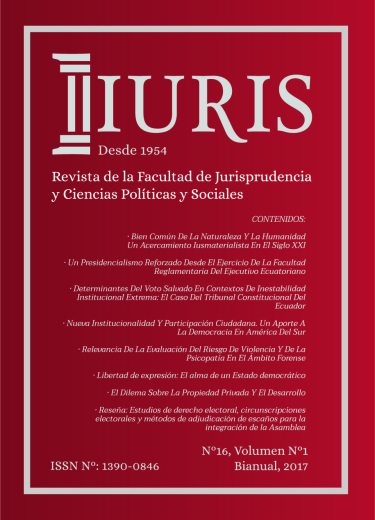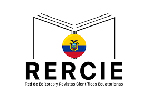DETERMINANTES DEL VOTO SALVADO EN CONTEXTOS DE INESTABILIDAD INSTITUCIONAL EXTREMA: EL CASO DEL TRIBUNAL CONSTITUCIONAL DEL ECUADOR
Resumen
Este artículo identifica las variables que explican el voto disidente en cortes de justicia que operan bajo condiciones de inestabilidad institucional extrema. Recurriendo a tres modelos de regresión logística, se propone que las preferencias ideológicas de los jueces constituyen un buen predictor del voto judicial disidente. Contrariamente al argumento clásico que señala que la inestabilidad de los jueces incentiva el voto estratégico, este artículo sostiene que esta relación se da solamente hasta un punto determinado en el que un incremento exponencial de inestabilidad institucional propicia el voto judicial sincero, aun cuando esto signifique formar parte de la coalición minoritaria o “perdedora”.
Palabras clave:
Ecuador, voto dividido, cortes constitucionales, inestabilidad judicial
Descargas
Citas
Barros, Robert. (2002). Constitutionalism and Dictatorship: Pinochet, the Junta and 1980. New York: Cambridge University Press.
Basabe-Serrano, Santiago. (2009). Estabilidad política y jugadores de veto judicial: un modelo espacial aplicado a cortes constitucionales. Revista OPERA, 9, pp. 121-134.
______. (2011). Jueces sin toga: políticas judiciales y toma de decisiones en el Tribunal Constitucional del Ecuador (1999-2007). Quito: FLACSO Ecuador.
______. (2012). Judges without Robes: Exploring Judicial Voting in Contexts of Institutional Instability. The Case of Ecuador’s Constitutional Tribunal (1999-2007). Journal of Latin American Studies, 44 (1): pp. 127-161.
Basabe-Serrano, Santiago y John Polga Hecimovich. (2013). Legislative Coalitions and Judicial Instability: The Case of Ecuador ́s Constitutional Court (1999-2007). Political Research Quarterly, 66 (1): pp. 154-166.
Brace, Paul y Melinda Gann Hall. (1990). Neo Institutionalism and Dissent in State Supreme Courts. Journal of Politics, 2, pp. 54-70.
______. (1993). Integrated Models of Judicial Dissent. Journal of Politics, 55, pp, 914-935.
______. (1995). Studying Courts Comparatively: The View from the American States. Political Research Quarterly, 48 (1), pp. 5-29.
Brigham, John. (1978). Constitutional Language: An Interpretation of Judicial Decision. Westport, Conn.: Greenwood Press.
Brinks, Daniel. (2007). The Judicial Response to Police Killings in Latin America: Inequality and the Rule of Law. Cambridge: Cambridge University Press.
______. (2010). Fieles servidores del régimen. El papel de la Corte Constitucional de Brasil bajo la Constitución de 1988, en Ríos Figueroa,
Julio and Gretchen Helmke (coord.), Tribunales Constitucionales en América Latina. Mexico: Suprema Corte de Justicia de la Nación, pp. 219-260.
Cepeda Espinosa, Manuel. (2005). “The Judicialization of Politics in Colombia: The Old and The New”, en Rachel Sieder, Line Schjolden, y Alan Angell (eds.), The Judicialization of Politics in Latin America. New York: Pelgrave, pp. 67-103.
Chávez, Rebecca. (2003). The Construction of the Rule of Law in Argentina: A Tale of Two Provinces. Comparative Politics, 35 (4), pp. 417-437.
______. (2004). The Rule of Law in Nascent Democracies: Judicia Politics in Argentina. Stanford: Stanford University Press.
Conaghan, Catherine M. (2012). Prosecuting Presidents: The Politics within Ecuador ́s Corruption Cases. Journal of Latin America Studies, 44 (4), pp. 649-678.
Correa Sutil, Jorge. (1993). The Judiciary and the Political System in Chile: The Dilemmas of Judicial Independence during the Transition to Democracy, en Irwin Stotzky (ed.), Transition to Democracy in Latin America: The Role of the Judiciary. Boulder: Westview Press, pp. 89 – 102.
Couso, Javier and Lisa Hilbink. (2010). Del quietismo al activismo incipiente: las raíces institucionales e ideológicas de la defensa de los derechos en Chile, en Ríos Figueroa, Julio and Gretchen Helmke (coord.), Tribunales Constitucionales en América Latina. Mexico: Suprema Corte de Justicia de la Nación, pp. 169-218.
Danelski, David. (1966). Values as Variables in Judicial Decision Making: Notes Toward a Theory. Vanderbilt Law Review, 19, pp. 721-740.
Epstein, Lee y Jack Knight. (1998). The Choice Justices Make. Washington, DC: Congressional Quarterly Press.
Epstein, Lee, Jeffrey A. Segal y Harold J. Spaeth. (2001). The Norm of Consensus on the U.S. Supreme Court. American Journal of Political Science, 45 (2), pp. 362-377.
Epstein, Lee, William M. Landes y Richard A. Posner. (2010). Infering the Winning Party in the Supreme Court from the Pattern of Questioning at Oral Argument,. Journal of Legal Studies, 39 (2), pp. 433-467.
Freidenberg, Flavia. (2006). Izquierda vs. Derecha. Polarización ideológica y competencia política en el sistema de partidos ecuatorianos. Política y Gobierno, XIII (2), pp. 237-78.
Gibson, James. (1983). From Simplicity to Complexity: The Development of Theory in the Study of Judicial Behavior. Political Behavior, 5, pp. 7-49.
Greenawalt, Kent. (1992). Law and Objectivity. New York: Oxford University Press.
Grijalva, Agustín. (2010). Courts and Political Parties. The Politics of Constitutional Review in Ecuador. Saarbrucken: VDM Verlag.
Hammond, Thomas, Chris Bonneau, and Reginald Sheehan. (2005). Strategic Behavior and Policy Choice on the U.S. Supreme Court.
Stanford: Stanford University Press.
Hall, Melinda y Paul Brace. (1989). Order in the Courts: A Neo Institutional Approach to Judicial Consensus. Western Political Quarterly 42, pp. 391 - 407.
Helmke, Gretchen. (2002). The Logic of Strategic Defection: Determinantes del voto salvado en contextos de inestabilidad institucional extrema: el caso del Tribunal Constitucional del Ecuador.
Court-Executive Relations in Argentina under Dictatorship and Democracy. American Political Science Review, 46 (2), pp. 291-302.
______. (2005). Courts Under Constraints. Courts, Generals and Presidents in Argentina. Cambridge: Cambridge University Press.
Hilbink, Lisa. (2007). Judges beyond Politics in Democracy and Dictatorship: Lessons from Chile. New York: Cambridge University Press.
Iaryczower, Matías, Pablo Spiller, and Mariano Tommasi. (2002). Judicial Independence in Unstable Environment: Argentina 1935-1998. American Journal of Political Science, 46 (4), pp. 699-716.
Kapiszewski, Diana, and Matthew Taylor. (2008). Doing Courts Justice? Studying Judicial Politics in Latin America. Perspectives on Politics, 6 (4), pp. 741-767.
Maltzman, Forrest, James Spriggs, y Paul Wahlbeck. (2000). Crafting Law on the Supreme Court: The Collegial Game. New York: Cambridge University Press.
Markovits, Richard. (1998). Matters of Principle: Legitimate Legal Argument and Constitutional Interpretation. New York: New York University Press.
Mejía Acosta, Andrés. And John Polga-Hecimovich. (2010). Parliamentary Solutions to Presidential Crisis in Ecuador, en Leiv Marsteintredet and Mariana Llanos (eds.) Presidential Breakdowns in Latin America. New York: Macmillan, pp. 73-90.
Nágel, Stuart. (1963). Off the Bench Judicial Attitudes, en Glendon Schubert (ed.) Judicial Decision Making. New York: Free Press, pp. 29-53.
Narayan, Paresh and Russell Smyth. (2007). What Explains Dissent in the High Court of Australia? An Empirical Assessment Using a Cointegration and Error Correction Approach. Journal of Empirical Legal Studies, 47 (2), pp. 401-425
Pérez-Liñán, Aníbal y Andrea Castagnola. (2009). Presidential Control of High Courts in Latin America: A Long-term View (1904-2006). Journal of Politics in Latin America, 1 (2), pp. 87-114.
Pritchett, C. Herman. (1948). The Roosvelt Court. New York: Macmillan.
______. (1941). Divisions of Opinion among Justices of the U.S.
Supreme Court. American Political Science Review, 35 (5), pp. 890-
898.
Posner, Richard. (1993). What Do Judges and Justices Maximize? (The Same Thing Everybody Else Does). Supreme Court Economic Review, 3, pp. 1 - 41.
______. (1995). Overcoming Law. Cambridge: Harvard University Press.
Prillaman, William. (2000). The Judiciary and Democratic Decay in Latin America: Declining Confidence in the Rule of Law. New York: Praeger Press.
Ríos-Figueroa, Julio y Matthew Taylor. (2006). Institutional Determinants of the Judicialization of Policy in Brazil and Mexico. Journal of Latin American Studies, 38 (4), pp. 739-766.
Rohde, David y Harold Spaeth. (1976). Supreme Court Decision Making. San Francisco C.A.: Freeman.
Rodríguez, César, Rodrigo Uprimny, y Mauricio García-Villegas. (2003). Justice and Society in Colombia: A Sociological Analysis of Colombian Courts, en Lawrence Friedman and Rogelio Pérez Perdomo (eds), Legal Culture in the Age of Globalization: Latin America and Latin Europe. Stanford: Stanford University Press. pp: 134-183.
Rodríguez Raga, Juan Carlos. (2010). La estrategia de repliegue de la Corte Constitucional de Colombia, 1992-2006, en Ríos Figueroa, Julio and Gretchen Helmke (coord.), Tribunales Constitucionales en América Latina. Mexico: Suprema Corte de Justicia de la Nación, pp. 137-168.
Sánchez, Arianna, Beatriz Magaloni y Erik Magar. (2010). Legalistas vs. Interpretativistas: la Suprema Corte y la transición democrática en México, en Ríos Figueroa, Julio and Gretchen Helmke (coord.), Tribunales Constitucionales en América Latina. Mexico: Suprema Corte de Justicia de la Nación, pp. 317-360.
Schmidhauser, John. (1961). Judicial Behaviour and the Sectional Crises of 1837-1860. Journal of Politics 23 (4), pp. 615-640.
Schubert, Glendon. (1965). The Judicial Mind: The Attitudes and Ideologies of Supreme Court Justices: 1946 – 1963. Evanston, III: Northwestern University Press.
______. (1974). The Judicial Mind Revisited: Psychometric Analysis of Supreme Court Ideology. New York: Oxford University Press.
Segal, Jeffrey A., Lee Epstein, Charles M. Cameron y Harold J. Spaeth. (1995). Ideological Values and the Votes in the U.S. Supreme Court Justice Revisited. Journal of Politics, 57 (3), pp. 812-823.
Segal, Jeffrey y Harold Spaeth. (2002). The Supreme Court and the Attitudinal Model Revisited. Cambrigde, UK: Cambridge University Press.
Smyth, Russell y Paresh Narayan. (2004). Hail to the Chief! Leadership and Structural Change in the Level of Consensus in the High Court of Australia. Journal of Empirical Legal Studies, 1 (2), pp. 399-427.
Smyth, Russell and Paresh Narayan. (2006). Multiple RegimeShifts in Concurring and Dissenting Opinions of the U.S. Supreme Court. Journal of Empirical Legal Studies, 3 (1), pp. 79-98.
Spiller, Pablo y Matthew Spitzer. (1995). Where is the Sin in Sincere? Sophisticated Manipulation of Sincere Judicial Voters (With Applications to Other Voting Environments). Journal of Law, Economics and Organization, 11, pp. 32-63.
______. (1992). Judicial Choice of Legal Doctrines. Journal of Law, Economics and Organization, 8, pp. 8-46.
Taylor, Matthew. (2008). Judging Policy. Courts and Reform in Democratic Brazil. Stanford: Stanford University Press.
Tsebelis, George. (2002). Veto Players: How Political Institutions Work. Princeton, New Jersey: Princeton University Press.
Uprimny, Rodrigo. (2004). The Constitutional Court and the Control of Presidential Extraordinary Powers in Colombia, en Siri Gloppen, Roberto Gargarella and Elin Skaar (eds.), Democratization and Judiciary: The Accountability Function of Courts in New Democracies. London: Routledge, pp. 33-50.
Verner, Joel. (1984). The Independence of Supreme Courts in Latin America. Journal of Latin American Studies, 16 (2), 463-506.
Wilson, Bruce M. (2010). Protección de derechos y rendición de cuentas: la Sala Constitucional de la Suprema Corte de Costa.
Rica, en Ríos Figueroa, Julio and Gretchen Helmke (coord.), Tribunales Constitucionales en América Latina. Mexico: Suprema Corte de Justicia de la Nación, pp. 91-136.







